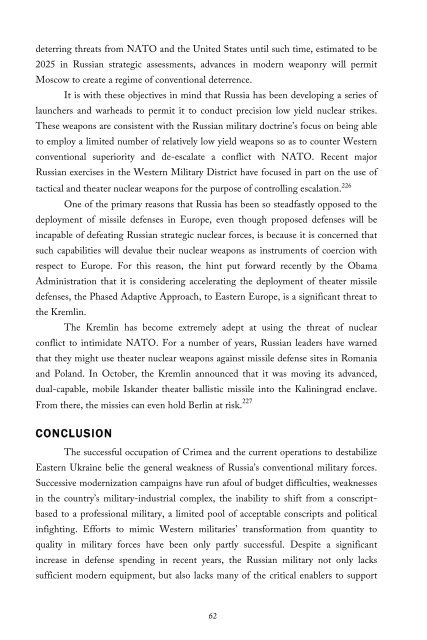Create successful ePaper yourself
Turn your PDF publications into a flip-book with our unique Google optimized e-Paper software.
deterring threats from NATO and the United States until such time, estimated to be<br />
2025 in Russian strategic assessments, advances in modern weaponry will permit<br />
Moscow to create a regime of conventional deterrence.<br />
It is with these objectives in mind that Russia has been developing a series of<br />
launchers and warheads to permit it to conduct precision low yield nuclear strikes.<br />
These weapons are consistent with the Russian military doctrine’s focus on being able<br />
to employ a limited number of relatively low yield weapons so as to counter Western<br />
conventional superiority and de-escalate a conflict with NATO. Recent major<br />
Russian exercises in the Western Military District have focused in part on the use of<br />
tactical and theater nuclear weapons for the purpose of controlling escalation. 226<br />
One of the primary reasons that Russia has been so steadfastly opposed to the<br />
deployment of missile defenses in Europe, even though proposed defenses will be<br />
incapable of defeating Russian strategic nuclear forces, is because it is concerned that<br />
such capabilities will devalue their nuclear weapons as instruments of coercion with<br />
respect to Europe. For this reason, the hint put forward recently by the Obama<br />
Administration that it is considering accelerating the deployment of theater missile<br />
defenses, the Phased Adaptive Approach, to Eastern Europe, is a significant threat to<br />
the Kremlin.<br />
The Kremlin has become extremely adept at using the threat of nuclear<br />
conflict to intimidate NATO. For a number of years, Russian leaders have warned<br />
that they might use theater nuclear weapons against missile defense sites in Romania<br />
and Poland. In October, the Kremlin announced that it was moving its advanced,<br />
dual-capable, mobile Iskander theater ballistic missile into the Kaliningrad enclave.<br />
From there, the missies can even hold Berlin at risk. 227<br />
CONCLUSION<br />
The successful occupation of Crimea and the current operations to destabilize<br />
Eastern Ukraine belie the general weakness of Russia’s conventional military forces.<br />
Successive modernization campaigns have run afoul of budget difficulties, weaknesses<br />
in the country’s military-industrial complex, the inability to shift from a conscriptbased<br />
to a professional military, a limited pool of acceptable conscripts and political<br />
infighting. Efforts to mimic Western militaries’ transformation from quantity to<br />
quality in military forces have been only partly successful. Despite a significant<br />
increase in defense spending in recent years, the Russian military not only lacks<br />
sufficient modern equipment, but also lacks many of the critical enablers to support<br />
62



